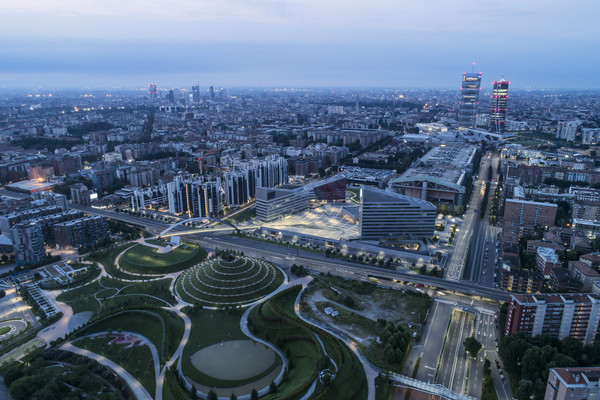
Urban greenery, an ecological challenge
The expansion of urban areas raises to the front the issue of public greenery needed to provide inhabitants with accessibility to a better quality of life. Among the various approaches to the design and management of green areas there are those which enhance spontaneous vegetation, proposals of criteria which can change the fruition of metropolitan areas based forms of vegetation taken over by mother nature
Reliable forecasts for 2030 find that 70% of the world’s population will be living in cities. An ongoing growth of housing is thus required. Among them an advanced social society as well as a sound quality of life. For this reason urban greenery will have an increasingly important role for changing the prevailing climate. This means overcoming the urban greenery concept as merely ornamental and considering a multifunctional value in a more general setting of integral policy of urban sustainability.
There is no lack of significant examples in Italy, such as what was achieved in Milan’s Porta Nuova and the City Life area. These city center areas which are frequented and feature the beauty of new buildings built there display great environmental and naturalistic values created there. The Porta Nuova project is for the requalification of the Garibaldi Station. New residential buildings and central directions have changed the skyline of these areas as well the green areas, gardens, bicycle lanes and pedestrian zones. The square dedicated to Gae Aulenti with skyscrapers and includes concrete water vases with foil plates and circular fountains which work to considerably lower summer temperatures. The Bosco Vertical (Vertical Forest) signed by Stefano Boeri is a pair of residential towers clad with plants and various species of bushes which has great impact. Also City Life is the result of a requalification project in the Fiera Campionaria area where there are not three great skyscrapers with a Shopping Center added to a municipal park with lush vegetation and an urban vegetable garden.
Importance of planning
The correct ecological management for the maintenance of greenery, especially in areas named for requalification, requires above all the right phase of planning. This means conducting the preliminary analyses of the site’s potential as well as as evaluation of the plant species to bring in. The time for selecting them involves the nature of the place, the morphology, physiology and plant health and their ability to adapt to climatic conditions, temperatures, rainfall and whether the climate is humid or dry, all factors which condition the results of the work. Also important is fitness, the ability of the plants provided to bring benefits to the site they will take over. Then it will be necessary to bring in everyone involved in planning, the inhabitants, associations and the enterprise for gaining an understanding of the needs expected by the locals. It must be recalled that phases of selection for the project will have fallout during the management and maintenance phases which requires unifying social and financial wellbeing according to the situation, quality and the entire surroundings.
Management and ecological means
The management of the ecology must aim, if not elimination, for minimizing the use of chemical products to reduce air and water pollution, limit the consumption of water by recovering rainfall, improving the perception of wellbeing of the users and the operators who work on the greenery.
In this way, for protecting the plants from parasites and weedinvestation can be done with a biological fight by using pathogen predators for the parasites and infestations. For the infestation fight, other than biological defense with limitations due to the need to identify the parasite for each type of weed, there are various alternatives. One is mulch by covering the soil with synthetic or natural materials. This solution is limited by the flow of air, the light which slows the rise of weeds and reduces water taken in. The use of polyethene film is effective but raises the problem of removing it. Otherwise a biodegradable plastic film can be used. For covering with natural materials there are straw, wood chips, others and also a vegetable cover. An example of vegetable covers is Trifolium repens, or white clover, with good results thanks to the competition of this plant working on investations.
A way to start the planting of a series is solarization. A polyethene sheet is extended over the soil for short times over seven days. The accumulation of the heat of the sun inhibits infestations and also eliminates fungus and noxious bacteria in the soil. What is needed is good isolation and high atmospheric temperatures because the result depends on high temperatures.
On surface structures such as pavements, streets or pathways machinery can be used against weeds. There are many varied options from rotating brushes, steel sheets or polyethene or cultivators mounted in small tractors.
Pyroerbicide is a thermal solution using direct flame or inducted heat to deliver thermal shock by cytoplastic membrane. The operations must take place on young weeds and has a minor effect on grass. Portable manual equipment or machines mounted or trailed by tractors can be used. Burners generate the flame, usually from propane gas, which only generates water vapor and carbon anhydrides and if the combustion is correct there is no smoke. In urban areas this method is used on paths or cobblestone streets.
Other thermic methods in these conditions for fighting infestations can be hot water at 95 °C – 120 °C which directly pulverizes weeds or hot water and biodegradabile foam. The foam allows the heat to remain in the soil and transmits it to the root stocks for a more effective treatment. A mix which gives good results is the mix of boiling water and a component of rapeseed oil which leaves a biodegradabile foam on the soil. A chemical treatment alternative is bioerbicidis based on natural substances capable of acting on contact on certain post-emergence weeds. This treatment with bioerbicidis must avoid drifting with the use of sprayers equipped with oriented and screened spraying.
The defense of plant parasites begins with ecological solutions aimed at an integrated combat which means integrated agronomic means, machinery, biological and chemical. Synthetic products, when possible, should be those based on natural principals for weeding treatments with the use of targeted and screened sprayers. To limit noise pollution of mechanical means in greens maintenance there should be an aim for electric motors which are achieving growing use.
Humanist ecology
When dealing with the management and ecological maintenance of greenery the theory of the work of Gilles Clément should be recalled. This Frenchman agonomist, entomologist, professor, landscaping architect and a self-defined gardener. He is known in the world for his theories based on respect for nature and thus for spontaneous vegetation. Clément maintained that what he defined as the Third landscape are areas set aside or abandoned by man such as road verges, railway right of ways and idle industrial areas, marginal places and the like. In these spaces refuge and prosperous spontaneous vegetation can be found as biodiversity reserves and should be respected as such. The Planetary Garden is another component he focuses on in his theories according to which the entire planet is an enormous green area, a great garden where all humankind are gardeners with the duty of caring for it. The same philosophy behind theory of Gardens in Motion means road routes and the paths in gardens and parks are changed in relation to the growth of spontaneous greenery. An example he achieved is the Parc André Citroën in Paris. Recently the Zen in Palermo, with the help of the citizens, restructured an abandoned area to create an urban oasis. According to Gilles Clément, nature must be left alone out of respect for it’s cycles, even in metropolitan cities, a theory which goes beyond the differentiation of urban oases.








